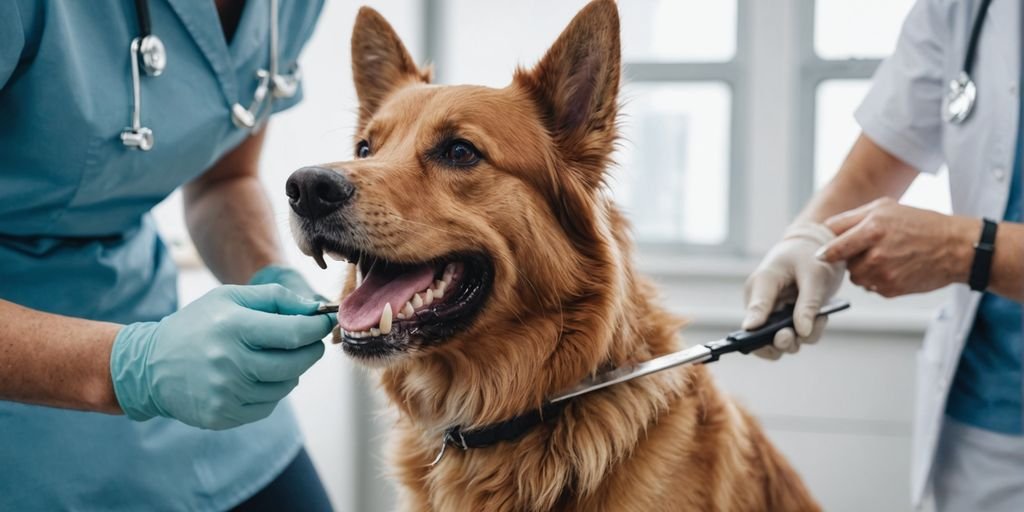Keeping your pet’s teeth healthy is crucial for their overall well-being. Just like humans, pets can suffer from dental issues that can lead to serious health problems if left untreated. This article will guide you through vet-approved tips and techniques to ensure your furry friend’s teeth stay in top condition.
Key Takeaways
-
- Regular brushing with pet-safe toothpaste can prevent plaque buildup and dental diseases.
-
- Professional dental cleanings are essential to remove tartar and check for hidden issues.
-
- Dental treats and chews can help maintain oral hygiene between brushings.
-
- Regular dental check-ups with your vet are crucial for early detection of dental problems.
-
- A balanced diet and safe chew toys can contribute to long-term dental health.
Understanding the Importance of Pet Dental Health
Impact on Overall Health
Good dental health is crucial for your pet’s overall well-being. Bacteria from plaque can enter the bloodstream, potentially causing damage to vital organs like the heart, liver, and kidneys. Regular dental care helps prevent these serious health issues.
Common Dental Diseases in Pets
Pets can suffer from various dental diseases, including periodontal disease, tooth decay, and gingivitis. These conditions can lead to pain, tooth loss, and infections if not treated promptly.
Signs of Dental Problems
It’s important to recognize the signs of dental problems in your pet. Look out for bad breath, broken or loose teeth, and discolored teeth. Other signs include abnormal chewing, drooling, and reduced appetite. If you notice any of these symptoms, it’s time for a dental check-up.
Effective Tooth Brushing Techniques for Pets
Choosing the Right Toothbrush and Toothpaste
Selecting the proper tools is crucial for effective pet dental care. Use a soft-bristled toothbrush designed for pets. Avoid human toothpaste, as it contains ingredients that can be toxic to animals. Instead, opt for pet-specific toothpaste, which often comes in flavors like chicken or peanut butter to make the experience more enjoyable for your pet.
Step-by-Step Brushing Guide
-
- Create a calm atmosphere before starting the brushing session.
-
- Let your pet get comfortable with you touching their mouth. Practice lifting your cat’s lips or gently massaging your dog’s gums with your finger.
-
- Introduce the toothbrush by letting your pet sniff and lick it.
-
- Apply a small amount of pet-specific toothpaste to the brush.
-
- Start brushing gently, focusing on the cheek-side of the teeth where plaque tends to accumulate.
-
- Gradually work up to a full cleaning, covering all teeth and gums.
-
- Reward your pet with a treat or praise to make the experience positive.
Overcoming Common Challenges
Pets may initially resist tooth brushing. To overcome this, start with short sessions and gradually increase the duration. Use positive reinforcement techniques, such as treats and praise, to encourage cooperation. If your pet continues to resist, consult your veterinarian for additional tips or alternative dental care options.
Regular tooth brushing is essential for preventing plaque buildup and maintaining your pet’s overall health. Consistency and patience are key to making this a stress-free routine for both you and your pet.
Alternative Dental Care Options

Dental Treats and Chews
Dental treats and chews are a popular choice for maintaining your pet’s oral health. These products are designed to help reduce plaque and tartar buildup. However, it’s important to choose products that are safe and effective. The Veterinary Oral Health Council (VOHC) provides a list of approved dental treats and chews that have been tested for safety and efficacy. Avoid giving your pet hard objects like bones or antlers, as they can cause dental fractures.
Water Additives and Dental Powders
Water additives and dental powders can be an easy way to improve your pet’s dental hygiene. These products are added to your pet’s drinking water or food and work to reduce plaque and freshen breath. When selecting a product, look for those that are VOHC-approved to ensure they are both safe and effective.
Dental Wipes and Gels
Dental wipes and gels are another alternative for maintaining your pet’s oral health. These products can be used to clean your pet’s teeth and gums, helping to remove plaque and prevent tartar buildup. Dental wipes are particularly useful for pets that are resistant to tooth brushing. For best results, use these products regularly and follow the manufacturer’s instructions.
Regular use of these alternative dental care options can significantly improve your pet’s oral health and reduce the need for professional cleanings.
Professional Dental Cleanings

When to Schedule a Cleaning
Regular professional dental cleanings are essential for maintaining your pet’s oral health. Most veterinarians recommend scheduling a cleaning at least once a year. However, pets with a history of dental issues may need more frequent visits. It’s crucial to consult your vet to determine the best schedule for your pet.
What to Expect During a Professional Cleaning
The process begins with an oral exam by a veterinarian. Radiographs (x-rays) may be needed to check the health of the jaw and tooth roots below the gumline. Since most dental disease occurs below the gumline, a thorough cleaning and evaluation are performed under anesthesia. This includes scaling to remove plaque and tartar, and polishing the teeth.
Post-Cleaning Care and Maintenance
After a professional cleaning, your pet may be a bit groggy but should recover quickly. To maintain their dental health, continue with regular brushing and use dental treats or chews. Follow your vet’s advice on any additional care needed to keep your pet’s teeth in top condition.
Regular professional cleanings, combined with at-home care, are key to preventing serious dental issues in pets.
Preventive Measures for Long-Term Dental Health

Regular Dental Check-Ups
Establish a regular dental care routine by scheduling check-ups with your vet. These visits help catch potential issues early and keep your pet’s mouth healthy. Aim for at least one dental check-up per year.
Diet and Nutrition for Healthy Teeth
A balanced diet is crucial for your pet’s dental health. Dry food can help reduce plaque buildup, while special dental diets are designed to promote oral hygiene. Avoid giving your pet sugary treats, as they can lead to tooth decay.
Safe Chew Toys and Bones
Provide your pet with safe chew toys and bones to help clean their teeth naturally. Avoid hard objects that can cause dental fractures. Opt for toys specifically designed for dental health, which can help remove plaque and tartar.
Consistency is key to maintaining your pet’s dental health. Regular care at home, combined with professional check-ups, can prevent many dental issues.
Addressing Dental Emergencies

Recognizing Dental Emergencies
Dental emergencies in pets can be alarming. Excessive drooling and pawing at the mouth are common signs that your pet may be in pain. Other symptoms include sudden changes in eating habits, bleeding from the mouth, and visible broken or fractured teeth. If you notice any of these signs, it’s crucial to act quickly to prevent further complications.
Immediate Steps to Take
If you suspect a dental emergency, follow these steps:
-
- Stay Calm: Your pet can sense your anxiety, which can make them more stressed.
-
- Inspect the Mouth: Carefully check for any visible issues like broken teeth or foreign objects.
-
- Avoid Hard Objects: Do not give your pet bones, antlers, or other hard objects as they can cause dental fractures.
-
- Contact Your Vet: Call your veterinarian immediately for advice and to schedule an emergency visit.
Seeking Veterinary Care
When you bring your pet to the vet for a dental emergency, the process usually starts with an oral exam. Radiographs (x-rays) may be needed to evaluate the health of the jaw and tooth roots. Most dental procedures will require anesthesia to ensure your pet remains still and pain-free during the treatment. Maintaining good oral hygiene after the procedure is crucial to prevent future dental issues. Always consult with a qualified veterinarian for the best care options for your pet.
Conclusion
In conclusion, maintaining your pet’s dental health is crucial for their overall well-being. Regular brushing, proper diet, and routine vet check-ups can prevent many dental issues. By following these vet-approved tips, you can ensure your pet enjoys a healthy mouth and a happy life. Remember, a little effort in dental care goes a long way in keeping your furry friend healthy and comfortable.
Frequently Asked Questions
Why is dental health important for pets?
Dental health is crucial for pets because it can affect their overall well-being. Poor dental care can lead to problems like bad breath, tooth loss, and infections that can spread to other parts of the body.
How often should I brush my pet’s teeth?
It’s best to brush your pet’s teeth daily. If that’s not possible, aim for at least 2-3 times a week to help prevent plaque and tartar buildup.
What type of toothbrush and toothpaste should I use for my pet?
Use a toothbrush designed for pets or a soft-bristled human toothbrush. Always use pet-specific toothpaste, as human toothpaste can be harmful to animals.
Are dental treats and chews effective for my pet’s dental care?
Yes, dental treats and chews can help reduce plaque and tartar buildup. Look for products with the Veterinary Oral Health Council (VOHC) seal of approval.
When should I schedule a professional dental cleaning for my pet?
Most pets need a professional dental cleaning once a year. However, some may require more frequent cleanings based on their dental health and breed.
What are the signs of dental problems in pets?
Common signs include bad breath, yellow or brown tartar on teeth, red or swollen gums, and difficulty eating. If you notice any of these signs, consult your veterinarian.


